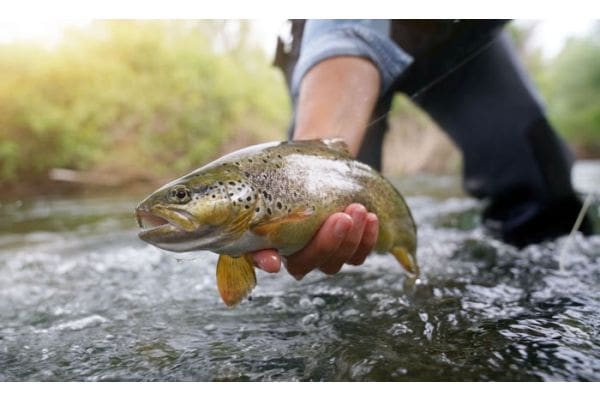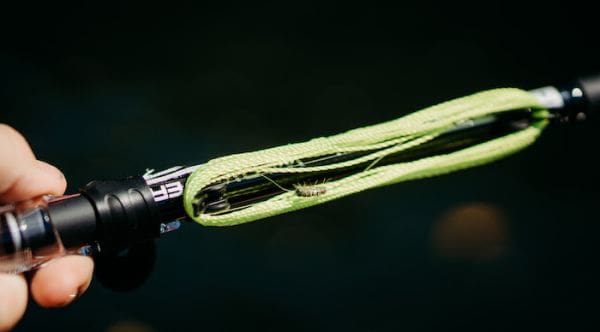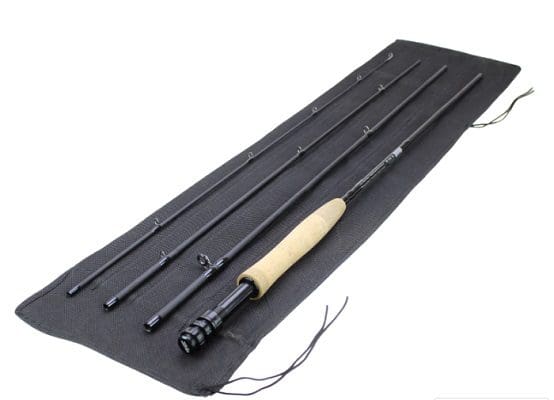WINTER IN VIRGINIA IS PRIME TIME FOR FLY FISHING ENTHUSIASTS

FISH THE SOUTH RIVER WITH WILD WATER FLY FISHING
BY:DALLAS HUDGENS
SOUTH RIVER
Winter is when only the gonzo anglers come out to play. Everyone else is curled up by the wood stove, but a select few enjoy standing in water when the air temperature is below freezing. If you’re looking to be one of those anglers, look no further because this is the guide to winter fly fishing South River and Virginia.
THE SOUTH RIVER
The South River Runs through the heart of the Shenandoah Valley in Waynesboro, Virginia. This spring-fed river stays the perfect trout temperature year-round, never getting too warm during the hot and humid summers and never freezing in the middle of winter.
Fishing at the base of the Blue Ridge Mountains, you might see snow-capped peaks when the sun pokes through the clouds. They’ll shine bright in the background as you mend your fly line and break ice from your guides.
If breaking ice from your guides doesn’t sound like a good time, then don’t worry. Virginia’s winters are mild compared to the rest of the country, with high temperatures generally in the 40s. Lows can get below freezing, so avoid fishing before mid-morning, as this is the best way to circumvent the worst of the cold weather. You should be wary of the weather, though. Daytime highs below freezing are possible, so ensure you always have a layered clothing system packed away.
You can use neoprene waders in freezing temperatures, but you usually need to layer sweat suits and compression tops and bottoms to keep warm under your waders. The good news is that the water will not be as cold as the air.
In winter, South River flows around 2.5-3 feet on the river gauge, which is ideal for wading.
Just because the water doesn’t freeze doesn’t mean you fish it like you would in Spring, Summer, or Fall. Insect hatches are minimal, and you only need a handful of flies to be effective.
FISHING THE SOUTH
My first winter fishing in the South was easily the coldest winter of the last ten years. There were several weeks in a row with highs that stayed in single digits or teens. The middle of the river flowed great, but a foot of ice had built up on the banks. I haven’t seen this before or since.
The first trip out was early in the morning. The high that day was supposed to be 17F and was sitting at 6F when I woke up. Waiting until the temperature was stable wouldn’t have changed the fishing much with it being so cold, so I decided to go early and be back at the house around noon to get some chili going and watch some football while warming up.
I live on the other side of the Blue Ridge, and as I drove up and over the mountain, I looked down at the basin below and saw it had snowed overnight. The valley can have completely different weather than where I live despite only being twenty minutes away. The snow didn’t affect the fishing but did add a nice aesthetic.
I had bundled up at the house and drove to the river in my waders. I had also assembled my Wildwater 5-6 Weight Fly Rod and tied flies onto my leader. Finger dexterity is minimal when the weather gets cold, so having everything tied beforehand can save time and improve knots.
The easiest part about fly fishing in the winter is that you only need one fly style, midges. It’s best to have a few different colors you can experiment with to see what the fish like best. Size 20 is an excellent place to start.
I tied on a size 10 Black Wooly Bugger and a size 20 black midge as a dropper off the bend of the hook, using 6x Flourocarbon Tippet. It was a cloudy morning, and the snow must have previously been falling as rain because the water wasn’t as clear as usual.
I stick with dark colors when the water is dingy and the conditions are cloudy. The larger wooly bugger acts as an attractor the trout can see. They might not be interested, but it will get them looking in the area where your midge will soon float by.
SOUTH RIVER INHABITANTS
The occasional native brook trout finds its way into the river; however, it’s pretty rare. Most of the time, you’ll be catching stocked rainbow and brown trout. Thanks to the ever more strict conservation laws, the state is now seeing some wild trout start to gain a foothold in the river. There are not many, but hopefully, they continue to flourish.
I only caught rainbows this morning, and all of them were stockers. The four I caught weren’t huge but hovered in the foot-long range. Each one took the midge. Of course, it’s impossible to tell if they only took it because they saw the bugger first, but I can attest to having better days nymphing when I drop a smaller fly off an attractor.
After releasing the last fish, I decided to leave. My hands were red and had begun to feel numb to the point where pinching the fly line took a concentrated effort. It was the first of many days I spent fishing the South during winter, but it was easily the coldest.
About Wild Water Fly Fishing
Wild Water Fly Fishing represents a dedication to bringing friends and family together by providing everything you’ll need to gear up for a trip to the lake. If you’re a parent or grandparent wanting to nurture a kid’s interest in fly fishing, Wild Water provides the best tools to make your fly fishing trip an unforgettable experience. Wild Water Fly Fishing is the only company to focus exclusively on affordable, easy-to-use fly fishing starter packages for all species of fish.



